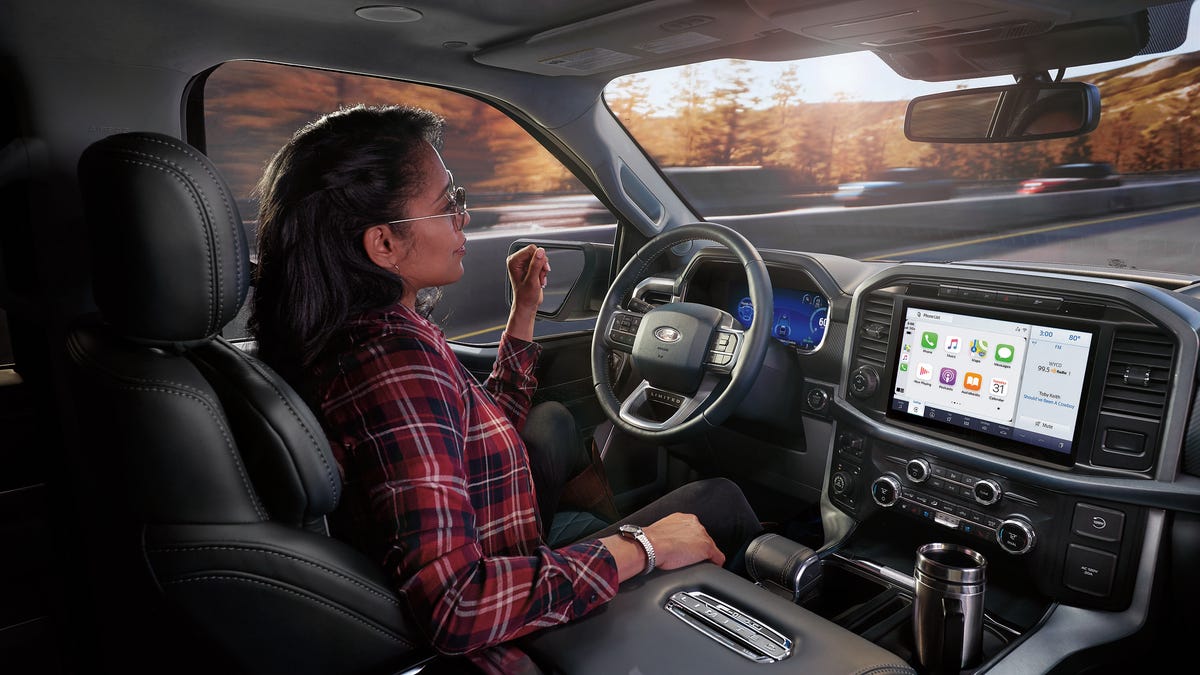Ford's BlueCruise driving aid is easy-peasy hands-free tech
Ford's hands-off Level 2 driver aid is a smooth, straightforward way to reduce tedium on long drives.
Like General Motors' similarly named (and similarly capable) Super Cruise, Ford's new BlueCruise technology is meant to reduce the tedium of driving on long stretches of limited-access highway. It is, like other Level 2 driver-assistance systems, a combination of adaptive cruise control, lane-keep assist and -- if the driver enables it in the settings menu -- speed-limit recognition. It will hold the vehicle in its lane and keep pace with traffic over some 100,000 miles of premapped highway segments across the US. And after a bit of seat time, I'm pretty impressed.
To get a brief taste of BlueCruise, I hopped behind the wheel of a 2021 Ford F-150 at Ford's headquarters in Dearborn, Michigan. The F-150 is one of two vehicles that will carry BlueCruise when the system launches, the second being the Mustang Mach-E electric crossover. While the feature won't be in cars for a couple more months, eager buyers can option a vehicle today with all the necessary hardware, and BlueCruise will activate in owners' cars via over-the-air software updates. Ford expects some 80% of Mach-E buyers to opt for BlueCruise, and while the expected take rate in F-150 is just 15%, you have to consider the sheer volume of trucks that Ford ships out every year. Fifteen percent of a bajillion is still a pretty big number.
BlueCruise is limited to the highways seen on this map for the time being, but Ford hopes to expand these areas as time goes on.
BlueCruise is activated by pressing the usual cruise control button on the steering wheel. The left side of the F-150's gauge display shows a steering wheel with hands clearly wrapped around either side, signaling the system is not yet ready to let me relinquish control. However, when the time comes, the tachometer and hands fade away while "hands-free" displays prominently. GM's Super Cruise uses lights in the steering wheel to denote system status, and while it's better for keeping my eyes closer to the horizon, I could see it being a potential issue for folks dealing with red-green colorblindness. No such problem with BlueCruise.
On the road, BlueCruise is great. It does precisely what it's supposed to -- nothing more, nothing less. Keeping my eyes on the traffic ahead, BlueCruise keeps the car well positioned in its lane, although like Super Cruise, it sometimes favors the right side a little more than I'd like in a vehicle this girthy. Small-scale adjustments are smooth and changing lanes, while not yet part of BlueCruise's portfolio, isn't exactly difficult -- just hit the turn signal and use your hands, then wait for the screen to display "hands-free" once again. It's worth noting that my limited time with BlueCruise only covers well-made, clearly delineated highways, so I'll need some more time in jankier conditions to see how it handles those. But as far as first impressions go, this is a good one.
The left side of the F-150's gauge cluster makes it obvious when it's OK for your hands to leave the wheel.
In the event the car gets to a part of the road that isn't approved for BlueCruise, or if the vehicle needs the driver to retake control for whatever reason, an audible chime accompanies a written request on the gauge display. The camera responsible for monitoring the driver's eyes is tucked away above the infotainment screen, so you don't have to worry about repositioning the steering wheel where it accidentally blocks the cameras, as is the case with the Mercedes-Benz EQS's driver aids. It will function if the driver is wearing either sunglasses or a mask, but it won't operate if both are worn simultaneously, as the camera doesn't have much face left to track at that point.
BlueCruise won't stop with Mustang Mach-E and F-150, either. While Ford hasn't delved into specifics just yet, it said it plans to expand the Level 2 aid to more vehicles in the future. Your road trips will soon be that much easier.


